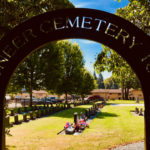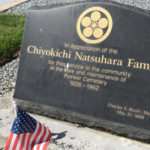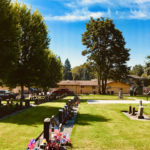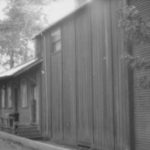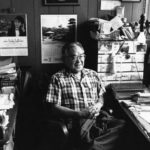Auburn Pioneer Cemetery’s deep roots in Japanese family, WWII internment, and more
Aug 21, 2019, 7:49 AM | Updated: Aug 27, 2019, 10:30 am
A ceremony Thursday evening will dedicate the newly restored Auburn Pioneer Cemetery.
It’s been known by a lot of names over the many decades, including “Faucett Cemetery,” the “Cemetery at Slaughter” (when Auburn was previously known as Slaughter, for a fallen soldier of that name), and the “Japanese Cemetery.”
Though its name has changed, the cemetery’s origins remain emblematic of 19th-century local history.
Auburn Pioneer Cemetery is on the southeast corner of Auburn Way North and 8th Street NE near the Fred Meyer. Because of the commercial buildings and busy traffic in that area, it’s easy to drive past that corner without having any idea what’s behind the ornate fence.
The recent restoration work took place over several years, and was lead by the White River Valley Museum and the City of Auburn. The grounds have been lovingly restored with new pathways and new “grave surrounds” (gravel areas that help protect headstones), as well as a new gathering space and interpretive panels.
Funding for the project came from 4Culture, the Washington State Department of Archaeology and Historic Preservation, and community donors.
In the pioneer era, the land where the cemetery sits was farmed by the Faucett Family, and the first known burial, of a member of the Faucett Family, took place in the 1860s. However, before the Faucetts lived there, the Brannan family had initially claimed the land. When a number of settlers died in the violence of the Treaty War between 1855 and 1856, it’s believed that their remains were buried on the Brannan farm.
Some historians believe this may be the same land that the Faucett family eventually used for their burials and what eventually became the Auburn Pioneer Cemetery. Either way, the Auburn Pioneer Cemetery is at least 150 years old.
The dedication ceremony will take place at 6:00 p.m. on Thursday, August 22. The event is free and open to the public, and is presented by the White River Valley Museum, Mountain View Cemetery, the White River Buddhist Temple, and Seattle Betsuin Buddhist Temple.
Japanese roots
The Auburn Pioneer Cemetery is remarkable for its long history and for the number of Japanese settlers who are buried there, and it’s especially remarkable how one family in particular has cared for it for more than a century.
Rachael McAlister is director of the White River Valley Museum. On a tour of the Auburn Pioneer Cemetery a few days ago, she pointed out a section of distinctive headstones.
“The ones that you see over here, they were all created in Chiyo Natsuhara’s warehouse,” McAlister said. “They had a store here in town, and a warehouse where they replaced all the wooden grave markers with these concrete grave markers. They’d build a wooden frame and Reverend Takamara, who was the reverend at the time at the Buddhist temple, just used a stick to write the kanji [a Japanese alphabet] in all of these. So you can see, these are our some of our older grave markers for the Japanese community.”
Rachael McAlister says that around 1900, when Mountain View Cemetery was founded nearby on the hill above the valley, many of the European settlers’ graves were moved there from Auburn Pioneer Cemetery. Because the valley flooded often by Green and White Rivers, the high water wreaked havoc on buried coffins.
However, the remains of Japanese people, who had been cremated before being buried, were in much smaller receptacles that weren’t typically affected by floods. Thus, the Japanese graves — as well as a small number of pioneer graves — remained in the valley at the Auburn Pioneer Cemetery.
Chiyo Natsuhara
Chiyochi “Chiyo” Natsuhara – also known as “Charlie” – who owned the warehouse where the headstones were created, is a key figure in this story and in the history of Auburn. After emigrating from Japan in the 1890s, he worked for the railroad until he saved enough money to open an agricultural store on West Main Street in Auburn in 1916.
Natsuhara and his wife buried an infant daughter in the Auburn Pioneer Cemetery in 1906 and eventually created a memorial there to Chiyo’s parents back in Japan. McAlister says that the Natsuhara family was part of what was a large Japanese community of mostly farmers in the Auburn areas from the 1890s right up to 1942.
“During the height of Japanese immigration into the valley, Auburn had about 300 Japanese families,” McAlister said. “And then post-internment, we had about 25 return.”
In early 1942, an Executive Order signed by President Franklin D. Roosevelt meant that Japanese and Americans of Japanese ancestry were forced from coastal areas and incarcerated at inland camps in California, Wyoming, and Idaho.
Rachael McAlister says that the departure of Auburn’s Japanese families “was a big blow to the community as a whole, and this cemetery definitely felt it.”
“During internment, there was a lot of anti-Japanese sentiment in the valley, as well as across the state, and we saw that a lot of grave markers were destroyed or vandalized during that time,” McAlister said.
Among the damage at Auburn Pioneer Cemetery during World War II was a Jizo Buddhist monument honoring an Auburn Japanese woman who was murdered by her husband, who then also killed the couple’s four children.
At some point, three of the five Jizo statues disappeared. Part of the recent restoration included bringing three new Jizo statues from Japan to restore the monument.
Caring for the cemetery while interned
The enduring bright spot in this story is that the Natsuhara family, even though they were incarcerated in Idaho at Minidoka during World War II, they never stopped taking care of the Auburn Pioneer Cemetery.
As she stood in the cemetery a few days ago, shaded from the late morning August sun by evergreen branches, Rachael McAlister read aloud from a letter that Chiyo Natsuhara’s son Frank sent from Minidoka to the family’s friend and next door neighbor Ray Sonneman back in Auburn during World War II.
The letter reads:
Ray, I forgot to write sooner in regards to grass cutting at the cemetery. Dad went all over camp contacting people who had graves in Auburn and got together a small collection. I had a money order made earlier but forgot again to mail it. If you need more write.
Incredibly, the Natsuhara family, with help from the Sonneman family back in Auburn, took care of the cemetery – that is, they raised money to support its maintenance – even while they were being held against their will by the federal government a few hundred miles away.
McAlister finds this letter inspiring and encouraging, and believes others will, too.
“They were in an internment camp, and still their focus was on maintaining the cemetery,” McAlister said. “I think those are the stories that make this place relevant. And when you see a community’s care for land and for their history, you can’t help but feel that as well.”
What’s also incredible is that the man who wrote the letter, Frank Natsuhara, lived to be 88. He passed away in April 1999; the family store that had been in business since 1916 burned down in August 1999. Perhaps most incredible of all is that the letter was one of several recovered from the ashes of the fire by Frank’s son (and Chiyo’s grandson and namesake) Charles Natsuhara.
Charles Natsuhara is 64 and lives with his wife in Auburn. He’s a board member of the White River Valley Museum, and he’s still involved with caring for the cemetery (though the City of Auburn took ownership and took over regular maintenance back in 1962). The Buddhist Temple where Charles Natsuhara is a member conducts a ceremony there every Memorial Day Weekend, and he plans to be buried there someday himself.
He’s pleased with the restoration work, and seems glad that the missing Jizo statues have been replaced.
The Sonneman family
Beyond the shared caring for the cemetery during World War II, Charles Natsuhara told another remarkable story about his family and the Sonnemans, and what happened when his father and grandfather and the rest of the Natsuhara family – and the entire Japanese community – were forced to leave Auburn in 1942.
“They were very good friends to us,” Natsuhara said, referring to the Sonneman family. The Natsuhara’s agricultural store was next door to Sunset Laundry, which the Sonneman’s had founded in the early 20th century.
“And so we locked up the store and gave the keys to them, and asked them to look out for it for us, which they did,” Charles Natsuhara said. “One of the main reasons that we were one of the families that came back to the valley, or back to Auburn, was we knew that we had very good friends in the Sonnemans, [and] that they had taken care of the store.”
In many ways, while it’s a resting place for the deceased and a solemn gathering place that’s being dedicated in Auburn on Thursday, it feels like something far more powerful is being commemorated and celebrated: a powerful symbol of the strength of family, friendship, loyalty and honor, along with the magnetic pull of home ground.
When it came time to decide where the Natsuhara family would go after the war, the choice was clear.
“[We knew] that we had a place to come back to,” Charles Natsuhara said.
Note: The State of Washington Department of Archaeology & Historic Preservation is offering grants to communities looking to restore historic cemeteries; applications are due in late October.


